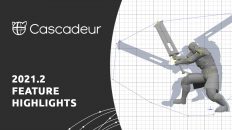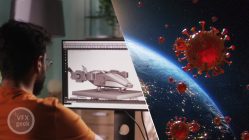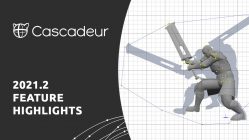Blender Foundation released Blender 2.9. Building on the success of the 2.8x series, Blender 2.90 continues to polish the user experience, introducing improvements to EEVEE, Cycles, sculpt, VR, animation, modeling, UV editing and so much more.
The list of new and upgraded features is very long. The most interesting ones are:
Sculpting: real multiresolution workflow
Blender 2.90 takes a significant step towards a true multiresolution workflow, with users now able to switch freely between subdivision levels while sculpting. It is now possible to unsubdivide models, or to rebuild missing subdivision levels automatically when importing high-resolution assets from other DCC software.
It is also now possible to toggle between three subdivision modes: the standard Smooth mode, plus the blockier Simple and Linear subdivision, geared more towards hard surface models.
Hard surface modelling: smart extrusion and better UV workflows
The modelling toolset gets a number of new features, but one of the most significant seems to be the new Extrude Manifold tool. Similar to Smart Extrude in 3ds Max, it cleans up non-manifold geometry created when extruding a model, automatically splitting or removing faces.
Another key change is the Correct Face Attributes and Keep Connected settings, which dynamically adjust the UVs of a mesh as it is being modified: again, something that should significantly speed up workflow.
In addition, the Bevel modifier gets support for custom Bezier profile curves; and the UV Editor gets new ring selection and Pick Shortest Path modes, plus the option to rip off selected faces to form new UV islands.
Simulation: better cloth and fabric tools
The simulation toolsets also recieved a number of individual updates.Cloth Filter is one of the most interesting ones. It applies the same solver used by the Cloth Brush – the headline-grabbing physics-enabled cloth sculpting brush added in Blender 2.83 – to an entire mesh, making it behave like fabric.
Full cloth simulations can also now mimic the effects of hydrostatic pressure: you can apply a pressure gradient emulating the weight of contained or surrounding fluid.
Fluid simulations get improved caching: by default, sims are now cached in VDB format, with a single .vdb file per frame, and it is now possible to apply a frame offset when importing caches from other software.
Rendering: Embree ray tracing and CPU viewport denoising in Cycles
Big changes to Blender’s render engines, with Cycles now using Intel’s Embree library for ray tracing on the CPU. This significantly improves Cycles performance in scenes with motion blur – up to 10x faster. Scenes with high geometric complexity also benefit on average.
Open Image Denoise (OIDN), Intel’s CPU-based render denoising system, is also now supported for viewport denoising as well as for final-quality output.
When rendering on the GPU, the OptiX backend introduced in Blender 2.81 now supports any OptiX-compatible card: from the old GeForce 700 series, to the latest Nvidia’s RTX cards.
Blender also now supports NVLink. When enabled in the Cycles device preferences, GPUs connected with an NVLink bridge will share memory to support rendering bigger scenes.
Eevee, Blender’s real-time render engine, takes another step to become a real production tool. Motion blur in EEVEE has been completely rewritten from scratch, adding support for mesh deformation, hair, and sub-frame accumulation for better precision.
Pipeline integration: more consistent Alembic and USD export, Nuke lens distortion
Blender 2.90 also features a number of changes that will be significant to studios integrating the software into production pipelines, including more consistent Alembic and USD export.
The Alembic exporter now uses the same codebase as its newer USD counterpart, using the same file naming scheme for meshes and particle systems, and numbering instances in the same way.
In addition, Blender now supports the same lens distortion model as Nuke, making it possible to track shots in Blender, then composite them in Foundry’s software or in Natron.
You can find out more about the release here: https://www.blender.org/download/releases/2-90/








Add comment